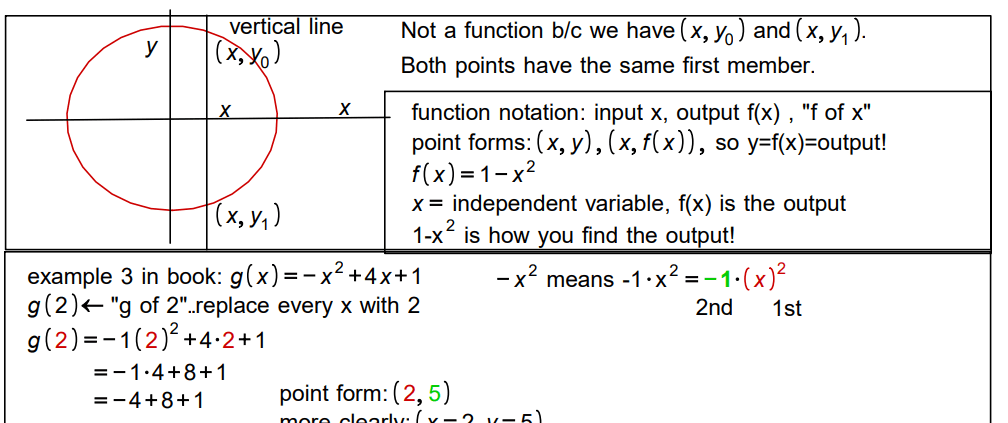Functions Defintions Vertical Line Test Domains Applications
Class Notes: Section 2.2/Functions
Notice: It’s getting to be flu/cold season. If you’re coughing a lot, please cover your mouth or wear a mask.
Definition:
A function is a set of points such that the first member of each point is unique.
Example 1:
f = { (1, 2), (3, 4), (5, 6) }, 1 ≠ 3 ≠ 5 so f represents a function.
Range: R = {2, 4, 6} (y-coordinates)
Domain: D = {1, 3, 5} (x-coordinates)
Example 1 (Book):
x, y: 2, 11; 2, 10; 3, 8; 4, 5; 5, 1 -> 2 repeats! This set of points is NOT a function.
Example 2:
Does x² + y = 1 represent a function?
Solve for y: y = 1 – x²
For x = 1, y = 0 (1, 0)
For x = -1, y = 0 (-1, 0)
1 ≠ -1, so x² + y = 1 is a function.
Example 2 (b):
-x + y² = 1
y² = 1 + x
y = ±√(1 + x)
For x = 3 (random value), y = ±2. We get (3, 2) and (3, -2). Single x (x=3) corresponds to two values of y. So, -x + y² = 1 is not a function.
Vertical Line Test:
When a graph intersects a vertical line ONLY ONCE, the graph represents a function. This is called the Vertical Line Test.
Advanced Function Concepts
Vertical Line
Not a function because we have (x, y₀) and (x, y₁). Both points have the same first member, x.
Function Notation
Input: x, Output: f(x), “f of x”
Point forms: (x, y), (x, f(x)), so y = f(x) = output!
f(x) = 1 – x²
x = independent variable, f(x) is the output
1 – x² is how you find the output!
Examples
Example 3 in book: g(x) = -x² + 4x + 1
g(2) = -1 × (2)² + 4 × 2 + 1 = -4 + 8 + 1 = 5 (output)
Point form: (2, 5)
3(b): g(t)
Every x gets replaced with t (on LHS and RHS)
g(t) = -t² + 4t + 1
3(c): g(x + 2)
Every x gets replaced by x + 2
g(x + 2) = -(x + 2)² + 4 × (x + 2) + 1
Expanded: -x² + 5
Finding Values for Which f(x) = 0
f(x) = -2x + 10
Setting f(x) equal to 0, -2x + 10 = 0
x = 5
Point: (5, 0)
5 is called the “zero” of the function, not because it’s 0, but because it makes y come out to be 0!
Example 7: Domains of Functions
f(x) = √x, x ≥ 0 ⟵ Inequality Form
Domain: [0, ∞) ⟵ [ because of the = part, infinity is a concept, not a number, so always )
Examples: √0.2, √0.001, √4, √10000343 (Not allowed here: √-5)
(a)
(b) g(x) = 1/(x + 5)
1/0 ⟵ not allowed here!
x + 5 ≠ 0 ⟵ x ≠ -5
Number Line: -∞ … -5 … ∞
Interval Notation: (-∞, -5) ∪ (-5, ∞)
Set-Builder Form: {x | x ≠ 5}
“Condition” in math means either true or false.
(c) h(x) = √(4 – 3x)
In general: √expression (expression is whatever≥0)
4 – 3x ≥ 0 ⟵ Apply definition of domain for square root functions
-3x ≥ -4 ⟵ x ≤ 4/3 ⟵ Inequality Form
Set-Builder Form: {x | x ≤ 4/3}
Verbalize as “set of all x such that x is less than or equal to four-thirds”
Picture Form: -∞ … 4/3]
Interval Form: (-∞, 4/3]
Example 8: Container Dimensions
Type: Right Circular Cylinder
Geometry: Circle Base, Lateral Area
V(r) ⟵ “V of r”
V = volume of can = amount of 3D space an object takes up!
Formula: V(r) = πr²h
Where:
- r = Radius
- h = Height
Ratio of height to radius is 4: h/r = 4 ⟶ h = 4r (Given)
V(r) Calculation:
V(r) = πr²(4r) = 4πr²r = 4πr³ ⟵ Only r remains!
Physical Interpretation:
- Can r = -0.1? No, not physical.
- Can r = 0? We can measure 0, but there is no physical object still.
- r > 0 ⟶ Then we have a real physical object we can hold.
- Interval for r: (0, ∞)

